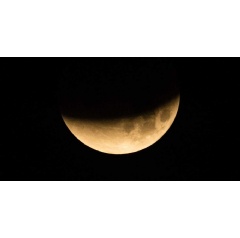The blood Moon: a guide to the longest lunar eclipse of the century
This weekend, the Moon will be eclipsed for an hour and 43 minutes.

It’s going to be the longest lunar eclipse of the twenty-first century, and a large proportion of people on Earth will be able to catch a glimpse of it.
A lunar eclipse happens when the Moon’s orbit takes it into the shadow of the Earth. This weekend’s eclipse will last so long because the Moon is nearly at apogee, the point in its orbit when it is furthest from the Earth. That will make it appear slightly smaller than normal.
The Moon will also spend a longer time in darkness than normal because its current path takes it right through the middle of Earth’s shadow.
What’s a blood Moon?Lunar eclipses also turn the Moon red, a phenomenon which is called a ’blood Moon’.
This happens because the Sun, Earth and Moon are in perfect alignment during a lunar eclipse.
The Earth is in the middle and blocks out most of the sunlight, but a little light will reach the Moon from around the edges of the Earth.
As this light passes through Earth’s atmosphere it will tend to refract, or bend, slightly. Blue light bends more than red light, so the blue light is more scattered.
More red light tends to make it to the Moon, and is then reflected off the lunar surface to come to Earth. So to us, the Moon appears red.
The video below records a bright full Moon over North America turned a lovely shade of celestial red during a total lunar eclipse. It was recorded on 4 April 2015.
Shortest Lunar Eclipse of the Century: https://www.youtube.com/watch?time_continue=1&v=KCOR2FFXf4IWhen does the lunar eclipse start?The eclipse will dazzle viewers on the evening of 27 July and morning of 28 July. Keen stargazers in east Africa, the Middle East and central Asia are likely to have the best view of the eclipse.
It will also be visible from elsewhere in Africa and Asia and parts of Europe, although no one in North America will be able to see it because the continent will still be in daylight when it happens.
If you’re in the UK, keep an eye out from 20.30 BST. In London, moonrise is at 20.49, so the moon will already be in the shadow of Earth as darkness falls over the capital. The total eclipse is expected between 21.20 and 22.13.
How do you watch it?It is safe to watch the eclipse without any eye protection or special equipment. For the best view, find a dark spot away from light pollution.
It’ll be easier if you’re in an open space, away from tall buildings, with a clear line of sight upwards.
When you live in a city, the trick is to find the biggest bit of sky you can, or get up as high as you can above the rooftops. A loft window, a rooftop, the windows of upper-storey flats or a local park (especially on the outskirts of a city) can work well as vantage points.
Ashley King, a planetary scientist based at the Museum, says, ’It’s not easy to observe space from cities. The light pollution is usually too much. However, there are a few spots you can go to. The general advice is get as high above buildings as you can and minimise the light in your vicinity.’
( Press Release Image: https://photos.webwire.com/prmedia/7/227026/227026-1.jpg )
WebWireID227026
This news content was configured by WebWire editorial staff. Linking is permitted.
News Release Distribution and Press Release Distribution Services Provided by WebWire.
